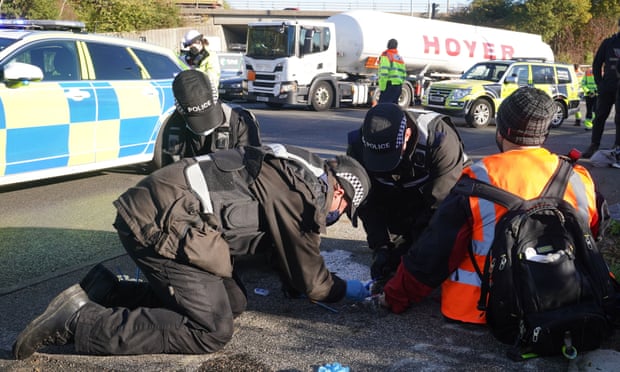UK climate activists held in jail for up to six months before trial
Campaigners say protesters arrested for blocking roads getting ‘lost in prison system’ while on remand

Climate campaigners arrested on suspicion of blocking roads or other offences are waiting up to six months in prison before being tried.
Josh Smith, a 29-year-old stonemason from Manchester, has been held on remand in HMP Peterborough for more than two months.
His court date is not set until 1 February, meaning he will have been incarcerated for half a year before any sentence may be imposed.
Smith, who is one of at least seven people being held long-term in prison awaiting trial, says the one positive about his position is that people seem more receptive to his message about the climate crisis.
Speaking from inside the jail, he said: “The only good thing about my situation is that it seems to give an extra platform for my views. I spend most afternoons writing speeches and they have been read out all over the world – Italy, Sweden, Canada.”
Rebels in Prison Support, a group that helps incarcerated campaigners, says any sentences given to non-violent, direct action protesters are likely to be shorter than their time spent on remand.
“It’s a total disgrace what happening. Many of these protesters are young and have had no connection with the police, never mind the judicial system, before becoming environment activists,” said Alice Reid, a spokesperson for the group.
A further 50 protesters were arrested and jailed last Friday, but many have been going through court hearings in recent days and some have been released on bail.
Reid tells of protesters being “lost in the prison system” as they are moved from one facility to another, seemingly because of overcrowding.
Prisoners can find it difficult to make contact with the outside world for days on end and Reid says it can take a lot of time to try to find out where they have been taken.
Louise Lancaster, a 56-year-old former teacher from Grantchester in Cambridgeshire, was arrested on the M25 and taken to a police station in Grays, Essex. Her husband had to put out a missing person alert to find her.
She said: “I was held for two days in Essex and then moved to Peterborough prison. I am meant by law to be allowed one phone call [to alert friends or family] and the police said they would do this, but they didn’t.” Essex police said this was down to human error.
Lancaster was quickly released on remand from Peterborough on the condition that she engage in no more “actions”, but her court hearing is not scheduled until October 2023. “If I had been remanded in jail, I would be facing over a year before trial,” she said.
The delays are partly due to the prison system struggling to cope with high numbers and a judicial system under severe funding and other constraints, as well as a huge backlog of cases resulting from the Covid lockdowns. There are 59,000 outstanding crown court cases and a continuing barristers’ strike threatens to make this worse in the short term.
A spokesperson for the Ministry of Justice insisted environmental campaigners were being treated equally under the law. “Decisions on bail applications are made by independent judges who ensure the public are protected. They have been prioritising remand cases following the unprecedented impact of the pandemic,” they said.
The detainees have mainly been arrested for road blockades organised by Insulate Britain or Just Stop Oil.
There is a high chance of more protesters joining their ranks soon. A coalition of groups including JSO, Jeremy Corbyn’s Peace & Justice Project, Fuel Poverty Action and others is planning to hold a large protest in Westminster on 1 October.
Record UK summer temperatures and severe flooding in Pakistan have heightened the urgency in the eyes of climate activists.
Smith admits he is not an entirely innocent victim. He has been arrested 24 times at protests in less than a year and has refused to commit to giving up demonstrating.
But he is also resolute that he is doing the right thing. “In a decade from now, when droughts are out of control, crop harvests are failing and the UK is experiencing food shortages, will I regret trying to do everything possible – even if that meant spending time in prison and getting a criminal record? No,” he said.
“My dad is supportive and my mum understands. But she is like any other mum – she would rather it was someone else’s son doing this.”
Lancaster has also been arrested more than 20 times and is facing charges that she knows could lead to her losing her freedom.
“I have tried every other method of convincing my local MP and government to take [the] climate crisis seriously and I have failed, so I am left with direct action,” she said.
“I am lucky to able to do this as I have a supportive partner who can look after my 17-year-old doing his A-levels next year. If going to prison is what I can do to get societal change to a tipping point then I must do it. This system is designed to frighten us and we won’t be frightened or stop.”
A spokesperson for JSO, confirmed large numbers of climate protesters were willing to break the law. “How many doctors, scientists, plumbers and grandparents are the government willing to put in jail before they face the truth that we must just stop oil and gas?” she said.




